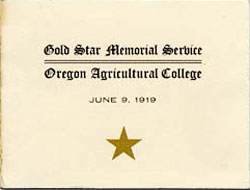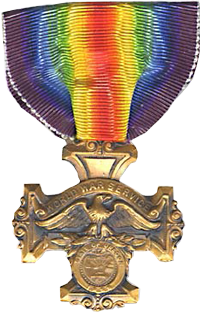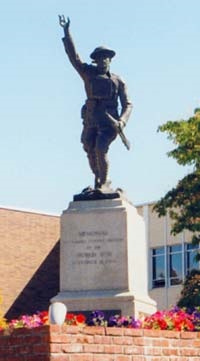Solemn Honors Across Oregon
 Services around the state praised the sacrifices of those who served in the military. (OSA, Oregon Defense Council Records, Publications and Ephemera, Box 8, Folder 1)
Services around the state praised the sacrifices of those who served in the military. (OSA, Oregon Defense Council Records, Publications and Ephemera, Box 8, Folder 1)
Oregonians honored the service and sacrifice of those in the armed forces with honor roll ceremonies, medals, and monuments in the years following the war. Churches, businesses, fraternal organizations, cities, and other entities had maintained honor rolls during the war with the names of their own who were fighting and sometimes dying for their country. During the war, homes that sent men into service proudly displayed a blue star in the window. But society reserved the gold star recognition for those who died in service during the war. Once the war ended, planning began for elaborate memorial services.
Oregon Agricultural College held a "Gold Star Memorial Service" on June 9, 1919. The college recorded 1931 of its people in service with 49 students and two members of the faculty honored for paying "the last full measure of devotion." Two service flags, made by the college's Home Economics Club, carried the names of all who served. The service included an invocation, music, speakers, and a cadet regiment before college president William Jasper Kerr read the names of those who died, followed by the playing of "Taps." Across the state similar services honored those who served and those "who made the supreme sacrifice in the World War."
By 1922 information from personal military service histories compiled by state historian Cornelia Marvin helped the Oregon Adjutant General's Office publish "Oregon's Honor Roll," listing Oregonians who died in military service during World War I. While the roll suffered from omissions, it did represent the most complete record available at the time.
"In Grateful Recognition of Faithful Service"
 World War Service Medal. (OSA, Oregon Military Department Records, Photos and Service Medals)
World War Service Medal. (OSA, Oregon Military Department Records, Photos and Service Medals)
The Oregon Legislature appointed a committee to decide on the design of a medal to award to Oregon veterans "to express the state's appreciation and gratitude for sacrifices made by her participants in the world war." The committee consisted of the governor, secretary of state, state treasurer, state librarian, and adjutant general.
The committee talked to artists both in Oregon and nationally about the design of the bronze medal. And, its secretary, the hard working Cornelia Marvin, collected literature and sample medals from several manufacturing companies. Recognizing the aesthetic limitations of a committee comprised mostly of politicians, they resolved to create an advisory art committee to help with the selection. The advisory committee was instructed to "select as beautiful and as artistic a design as it is possible to secure, and that the medal should be large enough to be distinct and plain at a distance."
The advisory committee soon balked at the amount of money appropriated for the medals, claiming that, at less than 23 cents per medal, the amount "would only permit the purchased of a commercial design that is in no way expressive of the feelings of the people of this state and would make no appeal to the men as a thing to be preserved and cherished." The committee recommended going to the next legislature for more money. Marvin also lobbied the governor to press for more money: "I was told the other day that the American Legion has paid 20c [cents] each for its buttons. The state ought to give something better than this little American Legion button." But the governor wanted to attempt to stay on schedule for presenting the medals in county ceremonies on Nov. 11, 1919.
 The Yamhill County Courthouse grounds includes this "Doughboy" statue, given the nickname of American infantrymen. The statue is one of many World War I monuments in Oregon. (Oregon State Archives scenic photograph No. 118)
The Yamhill County Courthouse grounds includes this "Doughboy" statue, given the nickname of American infantrymen. The statue is one of many World War I monuments in Oregon. (Oregon State Archives scenic photograph No. 118)
Another aspect of the process, however, made this impossible. Cornelia Marvin's work as state historian collecting military service histories was far from complete and it was needed to determine the recipients of the medals. Still, after receiving bids from several Oregon and national companies, the state pressed ahead, awarding the contract to the Whitehead and Hoag Company of New Jersey. They were to produce 32,000 medals, 800 of which were to have gold stars to honor those who died. Although many more Oregon men and women served during the war, the committee believed only 32,000 would claim medals. The final design of the medal read "World War Service" and included an eagle and the state seal. The back of the medal read "Presented by the State of Oregon in grateful recognition of faithful service during the World War 1917-1918."
Instead of the earlier planned county run ceremonies for distributing the medals, the adjutant general decided to give the duty to the local American Legion posts. While this ruffled some feathers of non-members and other organizations, most of the medals were distributed in this manner.
Monuments to Bravery
In addition to medals awarded for individual service, the Oregon Legislature wanted to encourage more collective expressions of appreciation and honor. In 1919 it authorized counties to spend county funds to erect "a proper and suitable memorial arch or monument of permanent material to the memory of the soldiers and sailors of said county who served in the late world war...." Mothers of many of those who died in the war, as well as other interested parties, also collected money to pay for the monuments. County courts supervised the construction of the monuments that were placed on county property in the county seat. Some consisted of a statue of a soldier in action with the names of those from the county who died in the war engraved in a bronze plaque on the base. Many continue to grace courthouse grounds throughout Oregon. Some, such as the Marion County monument, moved to other locations.
Notes
(Oregon State Defense Council Records, State Historian's Correspondence, Box 1, Folder 32, 33; Publications and Ephemera, Box 8, Folder 1, 3; Oregon Laws, 1919, Ch. 382, Ch. 99, 1921, Ch. 369)